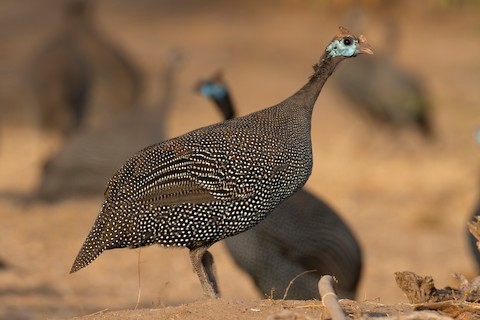Birdfinding.info ⇒ The northeastern form of Helmeted Guineafowl is generally uncommon across most of its range, but locally common in protected areas of the Rift Valley region. Sites where it can often be found include: in Ethiopia, Aledeghi Wildlife Reserve and Abidjatta-Shalla, and Awash National Parks; in Kenya, Buffalo Springs, Lake Bogoria, Samburu, and Shaba National Reserves, Mpala Ranch, and Ol Pejeta Conservancy; in Uganda, Murchison Falls, Lake Mburu, and Queen Elizabeth II National Parks; and in Rwanda, Akagera National Park.
“Ethiopian Guineafowl”
Numida meleagris meleagris
Eastern Africa, in arid savannas, brushlands, scrub, and other open and semiopen habitats.
From central Chad and the Central African Republic east across the Sahel to eastern Sudan, Eritrea, and Somaliland, and south to the northern D.R. Congo, Rwanda, and central Kenya.
A population of Helmeted Guineafowl occupies the southwestern Arabian Peninsula from around Mecca south to southern Yemen. Its origin—native or introduced—is unclear, but proximity suggests that is most likely this form.
Identification
The archetypal guineafowl: deep-bodied with a long, thin neck and small, mostly unfeathered head. The body and wings are blackish and densely covered with white spots throughout.
“Ethiopian” can be distinguished from other forms of Helmeted Guineafowl by the color and shape of its bare parts: pale-blue facial skin; a short brown casque; and dense bristles on the cere. Unlike all other forms of Helmeted Guineafowl, “Ethiopian” has no red on its head.
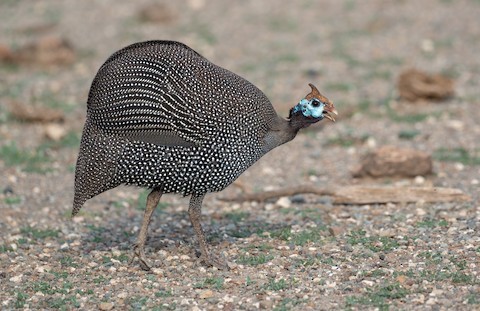
“Ethiopian Guineafowl,” N. m. meleagris. (Awash National Park, Afar, Ethiopia; June 15, 2019.) © Forest Jarvis
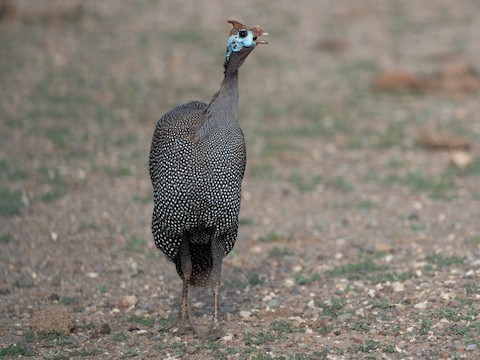
“Ethiopian Guineafowl,” N. m. meleagris. (Awash National Park, Afar, Ethiopia; June 15, 2019.) © Forest Jarvis
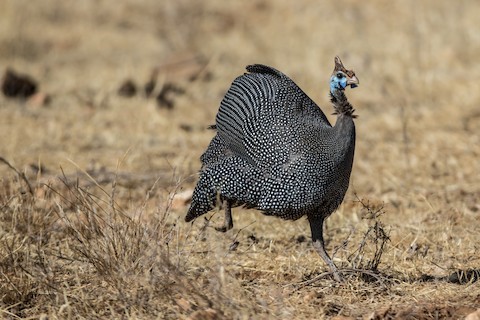
“Ethiopian Guineafowl,” N. m. meleagris. (Samburu National Reserve, Kenya; March 7, 2019.) © Louis Brodeur
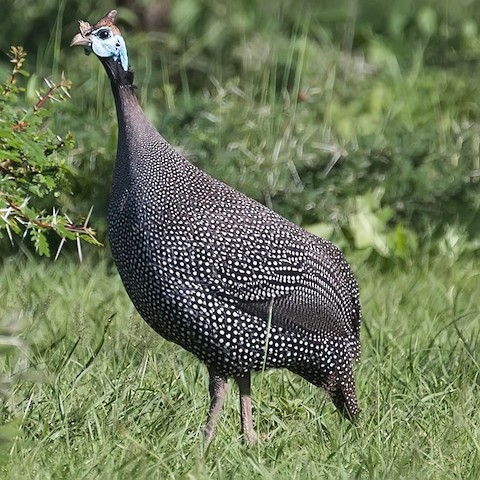
“Ethiopian Guineafowl,” N. m. Meleagris—note the cluster of bristles on the cere. (Yabello, Oromia, Ethiopia; October 30, 2019.) © www.aladdin.st
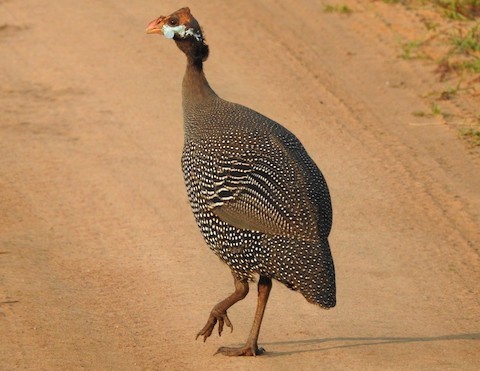
“Ethiopian Guineafowl,” N. m. meleagris. (Murchison Falls National Park, Uganda; June 16, 2019.) © Andy Frank
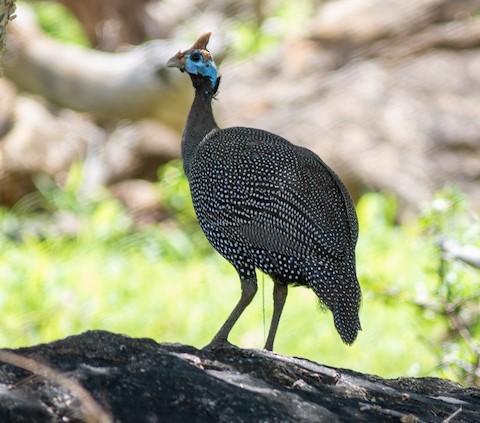
“Ethiopian Guineafowl,” N. m. meleagris. (Shaba National Park, Kenya; October 31, 2019.) © Susan Mac
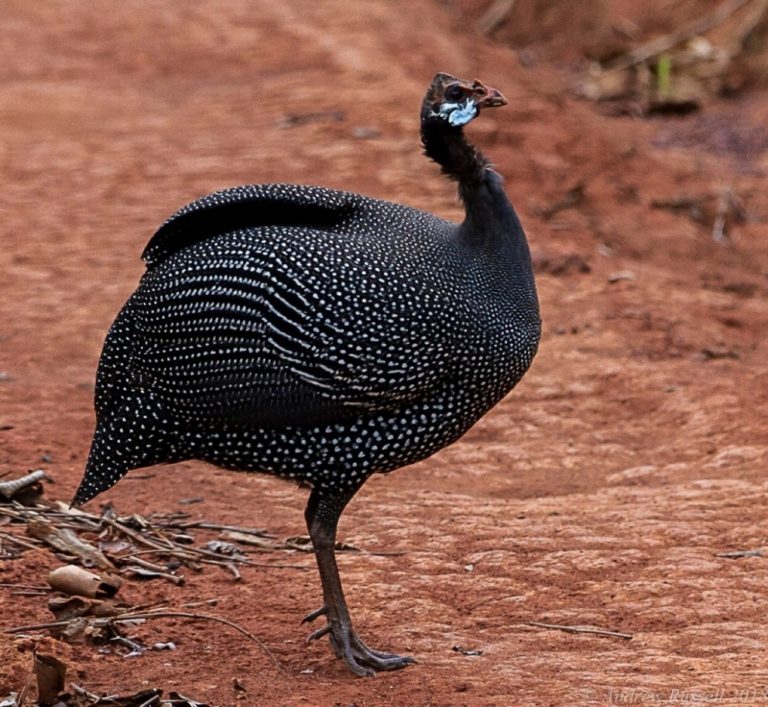
“Ethiopian Guineafowl,” N. m. meleagris. (Mbomou, Central African Republic; June 16, 2018.) © andrewjr
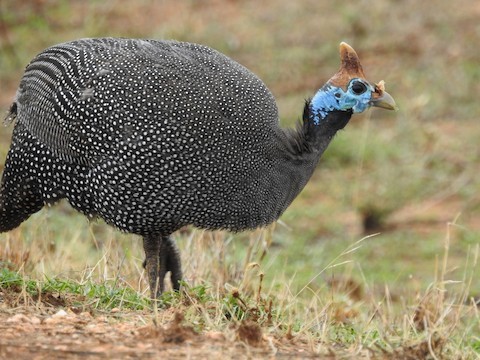
“Ethiopian Guineafowl,” N. m. meleagris, showing some degree of intergradation with “Reichenow’s Guineafowl” in the size and color of the casque and the extent of bare bluish facial skin. (Samburu National Reserve, Kenya; October 19, 2019.) © Mark Stacy
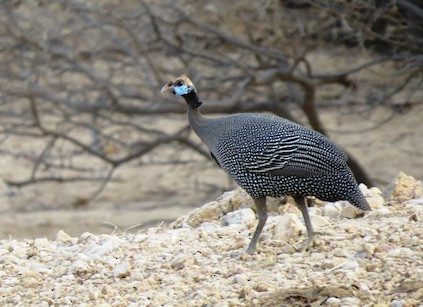
“Ethiopian Guineafowl,” N. m. meleagris. (Wadi Fira, Chad; April 29, 2015.) © Zlatan Celebic
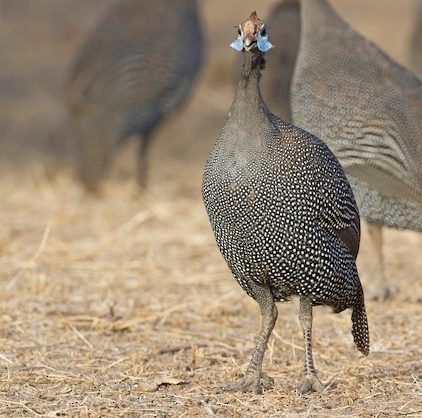
“Ethiopian Guineafowl,” N. m. meleagris. (Bilen Lodge, Afar, Ethiopia; December 29, 2012.) © Marco Valentini
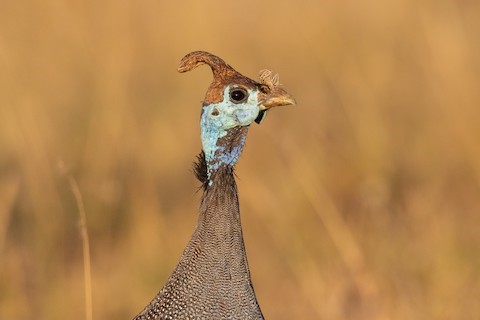
“Ethiopian Guineafowl,” N. m. meleagris, with an exceptionally curved casque, and showing the bristles on its cere. (Yabello, Oromia, Ethiopia; December 30, 2019.) © Stefan Hirsch
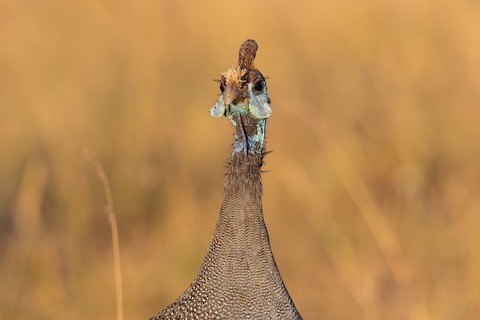
“Ethiopian Guineafowl,” N. m. meleagris, showing the width of the casque and flared bluish cheek-wattles. (Yabello, Oromia, Ethiopia; December 30, 2019.) © Stefan Hirsch
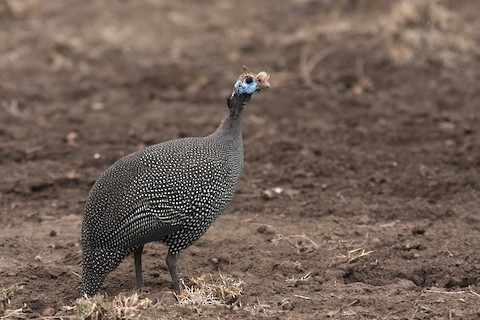
“Ethiopian Guineafowl,” N. m. meleagris, showing the bristles on its cere. (Awash National Park, Afar, Ethiopia; February 14, 2010.) © Guy Poisson
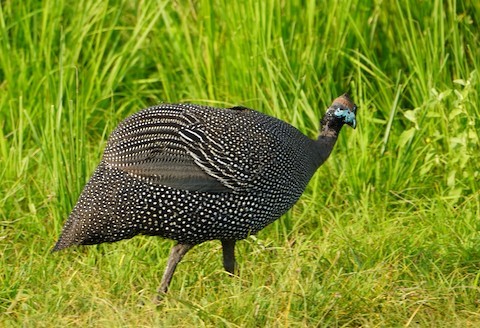
“Ethiopian Guineafowl,” N. m. meleagris. (Murchison Falls National Park, Uganda; July 4, 2019.) © Annette Teng
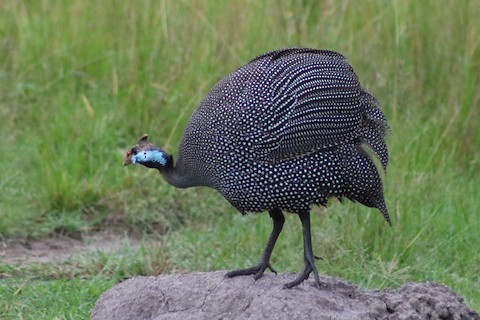
“Ethiopian Guineafowl,” N. m. meleagris. (Lake Mburo National Park, Uganda; July 7, 2019.) © Wendy Billock
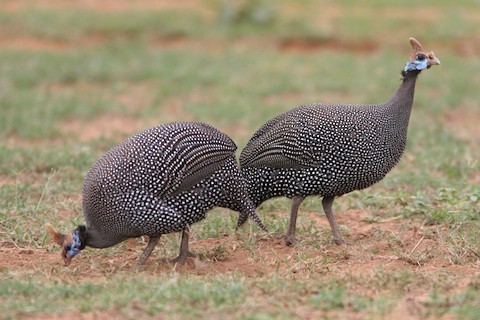
“Ethiopian Guineafowl,” N. m. meleagris, showing a large, orange-brown casques which indicate intergradation with “Reichenow’s Guineafowl,” N. m. reichenowi. (Mpala Ranch and Research Centre, Kenya; August 17, 2006.) © Brad Bergstrom
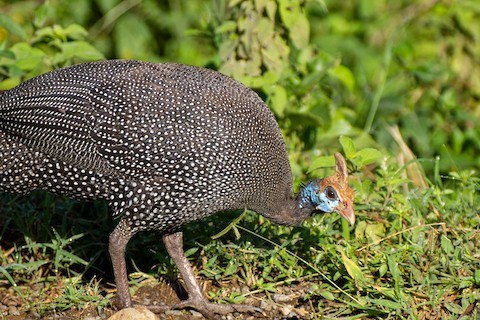
“Ethiopian Guineafowl,” N. m. meleagris, showing possible indications of some mixed ancestry—either “Tufted” or “Reichenow’s”—including a larger, more orange casque and a small red tip on its cheek-wattle. (Lake Nakuru National Park, Kenya; August 5, 2013.) © Alex G.
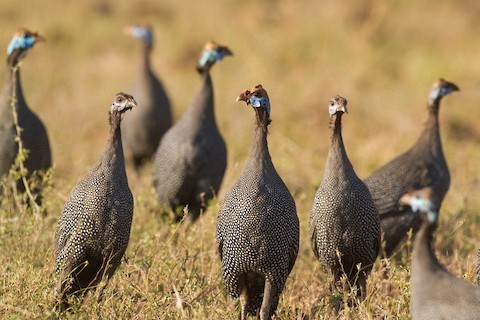
“Ethiopian Guineafowl,” N. m. meleagris, 6 adults and 2 immatures. (Omo National Park, Ethiopia; January 4, 2011.) © Lars Petersson
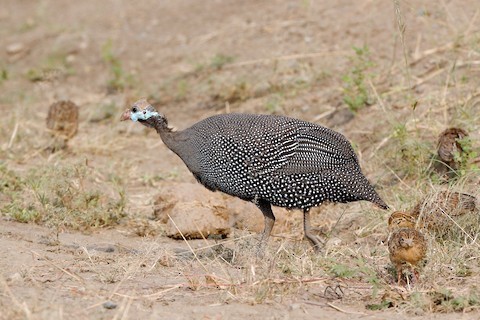
“Ethiopian Guineafowl,” N. m. meleagris, adult with chicks. (Ishasha, Queen Elizabeth II National Park, Uganda; July 14, 2018.) © Holger Teichmann
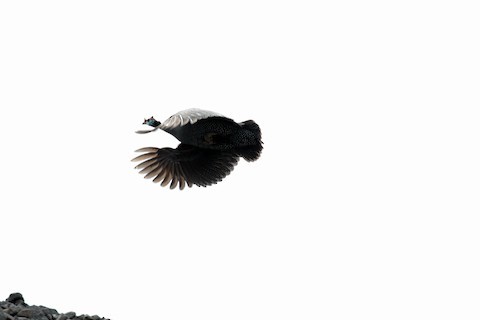
“Ethiopian Guineafowl,” N. m. meleagris. (Awash National Park, Afar, Ethiopia; May 5, 2019.) © Fikret Ataşalan
Cf. Other Helmeted Guineafowl. The forms of Helmeted Guineafowl are usually distinguishable based on the color and shape of the bare parts—although there is some internal variation within each form, as well as hybridization and some degree of apparent intergradation.
“Moroccan” has a small brown casque with elongated, upward-pointing feathers on the back of the head, whitish facial skinwhitish facial skin, and a “handlebar moustache” that consists of a long, broad, curled red wattle on each cheek, and a fleshy red connection across the cere.
“West African” has a small brown casque, whitish facial skin, and a “handlebar moustache” that consists of a long, broad, curled red wattle on each cheek, and a fleshy red connection across the cere.
“Ethiopian” has a small-to-medium-sized brown casque, bluish facial skin, and a cluster of bristles on the cere.
“Reichenow’s” has a very tall orange-brown casque, turquoise facial and neck skin, a black dewlap, and a “handlebar moustache” that consists of a long, broad, curled red wattle on each cheek, and a fleshy red connection across the cere.
“Tufted” has a tall orange-brown casque with a red base, red cere, turquoise facial and neck skin, a dark-blue or violet dewlap, and long, thin, pointed cheek-wattles that are bluish with red tips.
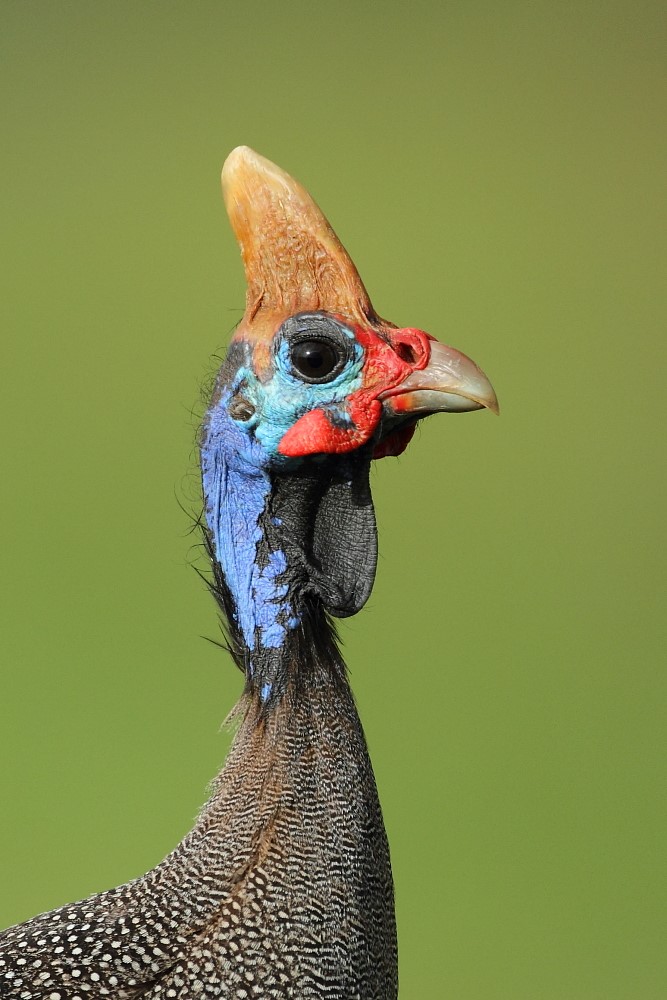
“Reichenow’s Guineafowl,” N. m. reichenowi, the champion of helmets, showing its distinctively tall orange-brown casque, red caruncles, turquoise cheeks, purplish neck-skin, and black dewlap. (Tarangire National Park, Tanzania; February 2, 2013.) © Darran Rickards
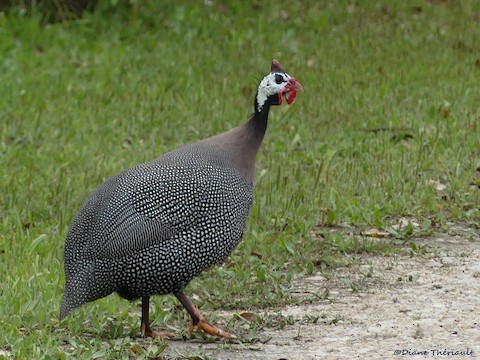
“West African Guineafowl,” N. m. galeatus, showing distinctive white facial skin, small casque, and red “handlebar moustache.” (Goose Island State Park, Texas; April 1, 2019.) © Diane Thériault

“Ethiopian Guineafowl,” N. m. meleagris, showing its small brown casque, bluish facial skin, and cluster of bristles on the cere. (Yabello, Oromia, Ethiopia; December 30, 2019.) © Stefan Hirsch
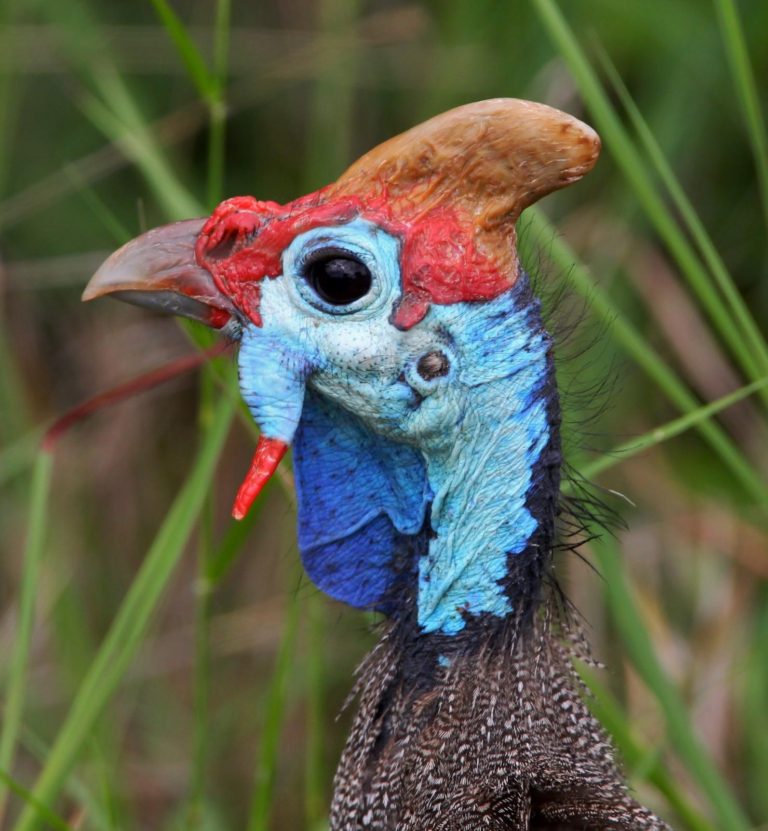
“Tufted Guineafowl,” N. m. mitratus, showing its orange-brown casque with a red base, red cere, turquoise facial and neck skin, a dark-blue dewlap, and long, thin cheek-wattles that are bluish with red tips. (Kruger National Park, South Africa; April 18, 2019.) © Guenther Karmann
Notes
Polytypic form consisting of two recognized subspecies. One of five potentially distinct forms of Helmeted Guineafowl (Numida meleagris). See Frontiers of Taxonomy: The Many-Helmeted Guineafowl, an Awkward Foursome.
References
BirdLife International. 2018. Numida meleagris. The IUCN Red List of Threatened Species 2018: e.T22679555A132052202. https://dx.doi.org/10.2305/IUCN.UK.2018-2.RLTS.T22679555A132052202.en. (Accessed April 16, 2020.)
eBird. 2020. eBird: An online database of bird distribution and abundance. Cornell Lab of Ornithology, Ithaca, N.Y. http://www.ebird.org. (Accessed April 18, 2020.)
Hollom, P.A.D., R.F. Porter, S. Christensen, and I. Willis. 1988. Birds of the Middle East and North Africa. T & AD Poyser, Calton, England.
Madge, S., and P.J.K. McGowan. 2002. Pheasants, Partridges, and Grouse: A Guide to the Pheasants, Partridges, Quails, Grouse, Guineafowl, Buttonquails, and Sandgrouse of the World. Princeton University Press, Princeton, N.J.
Martínez, I., and G.M. Kirwan. 2020. Helmeted Guineafowl (Numida meleagris). In Handbook of the Birds of the World Alive (J. del Hoyo, A. Elliott, J. Sargatal, D.A. Christie, and E. de Juana, eds.). Lynx Edicions, Barcelona. https://www.hbw.com/node/53526. (Accessed April 16, 2020.)
Xeno-Canto. 2020. Helmeted Guineafowl – Numida meleagris. https://www.xeno-canto.org/species/Numida-meleagris. (Accessed April 18, 2020.)
